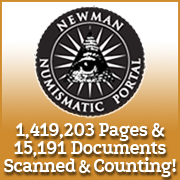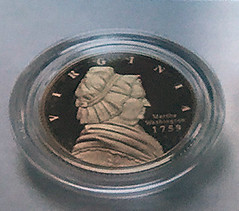
About UsThe Numismatic Bibliomania Society is a non-profit organization devoted to the study and enjoyment of numismatic literature. For more information please see our web site at coinbooks.org SubscriptionsThose wishing to become new E-Sylum subscribers (or wishing to Unsubscribe) can go to the following web page link MembershipThere is a membership application available on the web site Membership Application To join, print the application and return it with your check to the address printed on the application. Print/Digital membership is $40 to addresses in the U.S., and $60 elsewhere. A digital-only membership is available for $25. For those without web access, write to: Terry White, Treasurer AsylumFor Asylum mailing address changes and other membership questions, contact Terry at this email address: terrywhite5475@yahoo.com SubmissionsTo submit items for publication in The E-Sylum, just Reply to this message, or write to the Editor at this address: whomren@gmail.com BUY THE BOOK BEFORE THE COINSale Calendar |
- WAYNE'S WORDS: THE E-SYLUM OCTOBER 25, 2017
- NEW BOOK: A GUIDE BOOK OF GOLD EAGLE COINS
- NEW BOOK: WORLD OF LEADING BULLION COINS
- 1973 ALTERNATIVE CENT MATERIALS REPORT
- NEWMAN PORTAL SEARCH: GALAPAGOS ISLANDS
- ROBERT E. LEE IN NUMISMATICS
- HAPPY HALLOWEEN 2017
- ALTERNATE TERMS FOR 'CENTER DOT'
- NOTES FROM E-SYLUM READERS: OCTOBER 22, 2017
- CHICKASAW BIG KEYS AND THE YOCUM SILVER DOLLAR
- TRANSLATION OF THE 1783 CHARLES SPENER LETTER
- ONGOING THOUGHTS ON THE CONTINENTAL DOLLAR
- VOCABULARY TERM: FABRIC
- JOHN KIMBALL WIGGIN (1825-1875)
- PAN TO AUCTION JOHN MERCANTI PLASTERS
- COLONIAL PAPER RARITIES IN NEWMAN PART VIII
- WAYNE'S NUMISMATIC DIARY: OCTOBER 22, 2017
- VIDEO: ROYAL CANADIAN MINT'S GOLD PRODUCTS
- SWITZERLAND’S NEW TEN FRANC BANKNOTE
- SWISS BANKNOTE DESIGNER MANUELA PFRUNDER
- UKRAINE BANS RUSSIAN CRIMEA BANKNOTE
- ARTIST WINS AWARD FOR LINCOLN PENNY PORTRAIT
- FEATURED WEB SITE: BRIANRXM
Click here to access the complete archive
To comment or submit articles, reply to whomren@gmail.com
Content presented in The E-Sylum is not necessarily researched or independently fact-checked, and views expressed do not necessarily represent those of the Numismatic Bibliomania Society.
WAYNE'S WORDS: THE E-SYLUM OCTOBER 25, 2017
 This week we open with two new books, updates from the Newman Numismatic Portal, notes from E-Sylum readers, information and thoughts on the Continental dollar and the
ever-elusive Yocum dollar, Boston collector John Wiggin, colonial paper rarities and world banknotes.
This week we open with two new books, updates from the Newman Numismatic Portal, notes from E-Sylum readers, information and thoughts on the Continental dollar and the
ever-elusive Yocum dollar, Boston collector John Wiggin, colonial paper rarities and world banknotes.
Other topics this week include U.S. gold coinage, world bullion coins, alternative materials for the U.S. cent, Robert E. Lee, the Irving Berlin Congressional Gold Medal, John Mercanti plasters, and the 2017 U.S. Mint Forum.
To learn more about Galapagos Island counterstamps, Proceedings of the Numismatic and Antiquarian Society of Philadelphia, Netherlands/America Enduring Friendship medal, pewter dollars, the Yamassee War, banknote designer Manuela Pfrunder, Russia's Crimean banknote, and coins in TV episodes and movies, read on. Have a great week, everyone!
Wayne Homren
Editor, The E-Sylum
NEW BOOK: A GUIDE BOOK OF GOLD EAGLE COINS
Dave Bowers, Books, and America’s $10 Gold Coins
by Dennis Tucker, Publisher, Whitman Publishing
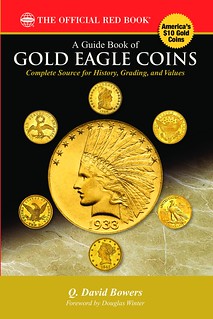 A new book on U.S. gold eagles ($10 coins) will debut just before Thanksgiving 2017.
A new book on U.S. gold eagles ($10 coins) will debut just before Thanksgiving 2017.
Its author, Q. David Bowers, nicknamed the “Dean of American Numismatics,” has been studying U.S. gold coins for more than 60 years, and writing about them almost as long. He has examined more than 5,000 numismatic catalogs, read countless periodicals, and studied all the available books on gold coins. On top of this old-fashioned “book learning,” he has personally examined hundreds of thousands of gold coins, many of them in the process of cataloging the most famous coin collections ever to cross an auction block.
His studying began even before he laid hands on his first gold coin. Dave has told me that when he was a young numismatist (he got started as a coin dealer in his early teens, in the 1950s), gold pieces weren’t seen very often. Even among the grownups in his hobby club such coins were rarely brought in for show-and-tell, or to trade. It wouldn’t be until the early 1970s that President Franklin Roosevelt’s Depression-era restrictions on gold ownership would be lifted. Then, Congress and the Treasury Department spent 10 years of trial and error developing a sustainable (and, as time would prove, very successful) gold-bullion program.
A New Modern Era for Classic Gold Coins
Since the 1986 debut of the U.S. Mint’s American Eagle coinage, Americans find it easier than ever to buy, sell, and trade gold bullion. On the numismatic side (apart from bullion coins), today many
factors make classic pre-1934 American gold coins easy to study, collect, and enjoy.
- The Guide Book of United States Coins (the perennial “Red Book”) gave numismatics a huge boost starting in the late 1940s. The Red Book is updated annually, with hundreds of thousands of copies distributed every year, making the coin-collecting hobby popular and accessible.
- World economic conditions brought an influx of U.S. gold coins back from Europe starting in the 1950s.
- The invention of modern professional third-party coin certification in the 1980s brought seemingly scientific stability to the subjective art of grading, and gave birth to a robust sight-unseen market.
- The communications boom provided by modern technology has made the available pool of gold coins broader and deeper for any collector with an Internet connection.
Books Rarer Than Coins
Gold coins haven’t always been this popular and accessible.
Looking back to the 1950s, when Dave Bowers started in the hobby, books about gold coins were even rarer than the coins themselves. In 1964 researcher Walter Breen wrote a 24-page monograph on gold dollars, focusing on die varieties. In 1975 numismatist David W. Akers, after spending more than 20 years researching gold coins (dollars in particular) and keeping detailed notes on their every aspect, published United States Gold Coins: An Analysis of Auction Records, Gold Dollars. Over the next seven years Akers compiled volumes covering every U.S. gold coin series. Breen, too, had continued to write monographs on other gold coins (up to the $10 denomination, published in 1967), and included gold coins in his two encyclopedias published in 1977 and 1988.
In the meantime, other researchers slowly added to the hobby community’s knowledge of U.S. gold coins. Articles were published in Numismatic Scrapbook Magazine, Numismatic News, Coin World, The Numismatist, Coins Magazine, and other periodicals. Cornelius Vermeule explored the aesthetics of U.S. coinage, including gold, in Numismatic Art in America (1971). Coin World published its Almanac in several editions starting in 1975, providing much technical information and data. Kenneth Bressett and others codified the grading of U.S. coins, including gold, in the Official American Numismatic Association Grading Standards for United States Coins (first edition, 1978). Later, Richard Doty, curator of the Smithsonian Institution’s National Numismatic Collection, wrote his wonderful America’s Money, America’s Story, and Roger W. Burdette dug into the National Archives and other primary sources to build his award-winning Renaissance of American Coinage books. The gold coins of individual mints were covered by Rusty Goe (Carson City), Douglas Winter (Carson City, Charlotte, Dahlonega, and New Orleans), and other specialists.
Bowers Makes His Entrance
In the midst of this activity, Q. David Bowers emerged as the preeminent author on U.S. gold coinage—a position he holds to this day.
Bowers’s History of United States Coinage, As Illustrated by the Garrett Collection, published in 1979, included his analysis of the nation’s gold coins. In 1982 he published United States Gold Coins: An Illustrated History. In 1989 his numismatic history of collecting U.S. gold coins was released as part of the proceedings of the Coinage of the Americas Conference. Various of his other books of the 1990s and early 2000s, plus hundreds of articles and columns before and since, have shared stories and insight on U.S. gold coins.
A Renaissance in Numismatic Publishing
In 2003 Bowers joined forces with Whitman Publishing, longtime publisher of the Red Book and other hobby books, signing on as the company’s numismatic director. This collaboration has led to a modern
renaissance in American book-publishing in the field of numismatics. The rising tide has lifted the ship of gold, so to speak. Since then Whitman has published an average of one new book either
entirely or substantially about gold coins per year, ranging from popular softcovers to (also popular) 650-page encyclopedias. We’ve also greatly expanded our coverage of gold coins in the Red Book,
“Mega Red” (the Deluxe Edition Red Book), and other publications. A few examples of recent gold-related Whitman books:
- 2004—Bowers’s Guide Book of Double Eagle Gold Coins was the first book to cover the entire spectrum of the $20 denomination since David Akers’s 1982 volume on the subject.
- 2005—Bill Fivaz armed collectors with guidance against gold-coin fakes in the United States Gold Counterfeit Detection Guide.
- 2006—The first edition of the monumental Encyclopedia of U.S. Gold Coins, 1795–1933, by Jeff Garrett and Ron Guth, covered every denomination from gold dollars to double eagles, circulated strikes and Proofs, plus patterns and commemoratives.
- 2006—Early U.S. Gold Coin Varieties: A Study of Die States, 1795–1834, by John Dannreuther and Harry W. Bass Jr., offered a detailed examination of every early gold die variety and die state.
- 2008—The first edition of Bowers’s Guide Book of Gold Dollars provided a complete source for history, grading, certified populations, die characteristics, striking and minting quality, auction records, and retail values. It would be updated in a second edition in 2011.
- 2010—GOLD: Everything You Need to Know to Buy and Sell Today (Bowers and Garrett) educated readers as gold prices soared following the 2008 financial crisis. The book would be updated in a second edition in 2017.
- 2011—Precious Metal: Investing and Collecting in Today’s Silver, Gold, and Platinum Markets expanded our coverage of the noble metals.
- 2013—American Gold and Platinum Eagles, by Edmund C. Moy, offered the retired Mint director’s perspective on the nation’s popular bullion programs.
- 2016—American Gold and Silver: U.S. Mint Collector and Investor Coins and Medals, Bicentennial to Date, by Dennis Tucker, gave a history and catalog of American Arts gold medallions, First Spouse and American Buffalo 24-karat gold coins, and other modern gold pieces.
As Whitman’s numismatic director, Dave Bowers advised on all of these books and more, while keeping up his own voluminous research and writing.
Up Next: Gold Eagles
The famous and influential Mr. Akers, who broke new ground publishing his numismatic research in the 1970s and 1980s, has said, “If one had a library consisting only of books and auction catalogs
that Dave Bowers has written, the field of U.S. numismatics would be quite thoroughly and satisfactorily covered. Such a claim could not be made about any other person, past or present.”
The Guide Book of Gold Eagle Coins—the 24th volume in the Bowers Series, and the 18th of those volumes written by Bowers himself—adds to and solidifies that distinction.
The book will begin shipping on November 21, 2017, and in the meantime can be pre-ordered online (including at Whitman.com). Readers will enjoy Bowers’s signature recipe of historical narrative, market analysis, and valuable advice. The Guide Book of Gold Eagle Coins covers the United States’ golden $10 coins minted from the 1790s to 1933. These include some of the Philadelphia Mint’s earliest coinage, the famed Turban Head eagles of 1795 to 1804; the long-running series of Liberty Head eagles, minted for nearly 70 years from the 1830s to the early 1900s; and the innovative Indian Head eagles of 1907 to 1933. Bowers explores the holdings of the National Numismatic Collection, the coins owned by King Farouk of Egypt, and other fascinating side journeys, all described in his engaging and informative style.
The Guide Book of Gold Eagle Coins will take its place in a rich line of numismatic books about U.S. gold. I hope it finds its way into your collection and that you enjoy and profit from it.
A Guide Book of Gold Eagle Coins
By Q. David Bowers; foreword by Douglas Winter
ISBN 0794845304
Softcover, 6 x 9 inches
448 pages
Full color
Retail $29.95 U.S.
https://www.whitman.com/store/Inventory/Detail/A-Guide-Book-of-Gold-Eagle-Coins+0794845304
NEW BOOK: WORLD OF LEADING BULLION COINS
 Metals Focus has announced the launch of it new reference book, The World of Leading Bullion Coins, at an event at the LBMA/LPPM Conference in Barcelona. The book was produced with
the support of five sponsors—the Perth Mint, the Austrian Mint, the Royal Canadian Mint, the Rand Refinery, and the Royal Mint.
Metals Focus has announced the launch of it new reference book, The World of Leading Bullion Coins, at an event at the LBMA/LPPM Conference in Barcelona. The book was produced with
the support of five sponsors—the Perth Mint, the Austrian Mint, the Royal Canadian Mint, the Rand Refinery, and the Royal Mint.
The World of Leading Bullion Coins details a historical account of each mint, including full-color photography of its complete suite of bullion coins. The mints in this book (the five sponsors, plus the United States Mint and China Gold Coin Inc.) represent the vast majority of bullion coins traded in the international market. The book also touches on why gold continues to resonate with the investor community and looks at some of the other ways in which coin investors can gain exposure to precious metals.
In addition to gold, The World of Leading Bullion Coins charts the development of silver bullion coins and the more recent additions of platinum, and, finally, palladium coins. Together, these help coin investors gain exposure across the precious-metal complex. Overall, many of these coins have had a notable bearing on consumption. Taken together, modern-day gold bullion coins have consumed some 5,000 tons (160 million ounces) of gold, while silver bullion coins have accounted for around 3,000 tons (over one billion ounces) of silver.
The modern era of the bullion coin as an investment began in 1967 with the launch of the 22-karat gold bullion Krugerrand. During the late 1970s and 1980s, the sector quickly grew to include the Canadian Maple Leaf (1979), the Chinese Panda (1982), the American Eagle (1986), the Australian Kangaroo, the U.K. Britannia (1987), and the Austrian Vienna Philharmonic (1989). In addition, the British Sovereign was re-launched in 1957, in response to the popularity of the one- and two-rand gold coins struck in South Africa (which were first issued in 1952).
For a hard copy of the book, please contact one of the sponsoring mints or email Metals Focus at info@metalsfocus.com. A flipbook and PDF will also available to view on many precious-metals websites, including that of Metals Focus.
To read the complete article, see:
The World of Leading Bullion Coins book launch
(http://news.coinupdate.com/the-world-of-leading-bullion-coins-book-launch/)
To read the complete book online, see:
World of Leading Bullion Coins (http://fliphtml5.com/nkzmn/awwy/basic/)

1973 ALTERNATIVE CENT MATERIALS REPORT
 While combing the stacks at Washington University in St. Louis, we recently discovered a 1973 government publication discussing alternative compositions for the Lincoln cent. The study,
Alternative Materials for One Cent Coinage, was initiated in response to rising copper prices, as the Treasury was well aware of the consequences of intrinsic value exceeding the face value of
coinage. Seemingly every citizen was searching pocket change for pre-1965 silver coins that could easily be sold at a premium to the local coin dealer. Had copper similarly risen in value, Lincoln
cents would have disappeared from circulation, only exacerbating the government’s financial loss on their manufacture.
While combing the stacks at Washington University in St. Louis, we recently discovered a 1973 government publication discussing alternative compositions for the Lincoln cent. The study,
Alternative Materials for One Cent Coinage, was initiated in response to rising copper prices, as the Treasury was well aware of the consequences of intrinsic value exceeding the face value of
coinage. Seemingly every citizen was searching pocket change for pre-1965 silver coins that could easily be sold at a premium to the local coin dealer. Had copper similarly risen in value, Lincoln
cents would have disappeared from circulation, only exacerbating the government’s financial loss on their manufacture.
Such publications were not marketed within the numismatic community as were the commercial publications of Krause, Whitman, and others. Individual researchers located them by chance, or perhaps they showed up occasionally in the inventories of numismatic booksellers, although a Newman Portal search of Fred Lake’s literature sales (125 in all) fails to locate even a single copy of this publication.
The work itself considers copper-zinc alloys, aluminum, steel, zinc, and even plastic, discussing the strengths and weaknesses of each. Copper prices dropped in the mid-70s, coincident with the recession, but strengthened at the end of the decade along with precious metals. This time, action was taken, and the cent composition changed during 1982 to 95% zinc, along with a weight reduction from 3.1 to 2.5 grams. Today, pre-1982 cents contain roughly 2 cents worth of copper, though it is illegal to melt them. Many speculate this restriction will be lifted if the Mint discontinues the one-cent coin.
Link to Alternative Materials for One Cent Coinage on the Newman Portal:
https://nnp.wustl.edu/library/book/537183
NEWMAN PORTAL SEARCH: GALAPAGOS ISLANDS
The Galapagos Islands, located 600 miles west of Ecuador, are today best known for their rich biodiversity, as popularized by Charles Darwin in the 19th century. A recent Newman Portal user entered “Galapagos,” in search of numismatic connections with this multifarious sanctuary. With a current population of 25,000, one would not expect to find a local coining facility, and, as a province of Ecuador, there is ample coin and currency produced on the mainland. Nevertheless, a numismatist will find a number of associated items.
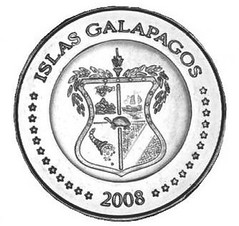

Five Dolares
The November-December 2009 issue of the NI Bulletin included an article by author Bill Mullan describing a modern series that celebrates the Galapagos wildlife. Struck in denominations from one centavo to eight dolares, these feature iguanas, turtles, finches, and other species. One would think these fall into the category of NCLT (non-circulating legal tender), which is commonly used by small countries to supply the collector and tourist trade. This series, however, was unauthorized by Ecudorian government and privately produced in the United States.
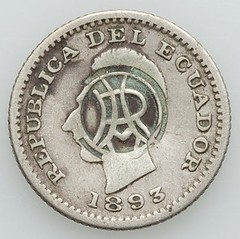
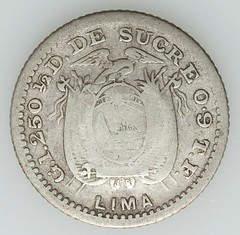
Counterstamp on 1893 half decimo, courtesy of Heritage Auctions
More recently, Dale Seppa wrote on Galapagos Island counterstamps, alternately described as “AR” or “RA”, in the November-December 2015 issue of NI Bulletin. These curious counterstamps, found on Ecuadorian and Peruvian silver dated c. 1900, were unknown in the U.S. until the mid-1960s. Seppa begins with a literature search (knowledge of Spanish is helpful) and analyzes the various theories regarding the origin of the counterstamps. No definite conclusion is reached, but the investigation is well-done, and the tantalizing question remains – were these contemporary, or produced after the fact? Seppa asks if any early 20th century auction catalogers mentioned these. The Newman Portal, with 5,000 auction catalogs from the 1850s to date, identifies none.
Finally, the Eric Newman correspondence has something as well. His letter of May 4, 1970, to Aaron “Buy the Book Before the Coin” Feldman observes of his visit to the Galapagos, “These are wonderful islands as they don’t even use money because the few human beings there merely keep accounts on one another.” That situation is presumably changed today, but Newman liked to acquire local money wherever he traveled, and no doubt made inquiries during this 1970 trip. Numismatics is wherever you find it, even in the Galapagos.
Link to November-December 2009 NI Bulletin on Newman Portal:
https://nnp.wustl.edu/library/book/520989?page=24
Link to November-December 2015 NI Bulletin:
https://nnp.wustl.edu/library/book/521025?page=35
Link to Newman-Feldman correspondence
https://nnp.wustl.edu/library/book/521911?page=170
ROBERT E. LEE IN NUMISMATICS
Public art reflects the identity, history, and priorities of the nation that produced it, from the largest statue to the smallest coin. As a discipline, numismatics helps us understand the imagery that appears on coins, medals, and paper money: who designed it, what inspired it, where it was used, and by whom.
The current debate about the disposition of monuments erected to honor the Confederate States of America enables us to examine what coins, medals, and paper money have in common with other forms of public art, along with the evident differences. The most obvious contrasts are scale and location: there are no numismatic items that are 10 feet tall, nor any that dominate a public square. On the other hand, government issued coins dominate the theoretical public square in a way that no single statue ever could.
The lack of a standard book, monograph, or article written on the coins and medals that depict Robert E. Lee is an intriguing omission in the literature. The resources of the Newman Numismatic Portal can help fill that gap. If an author ever wished to catalogue Lee’s numismatic memorials, this would be a prime place to begin.
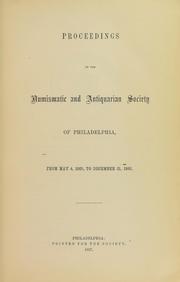 The first reference to a numismatic item related to Lee appears in the Proceedings of the Numismatic and Antiquarian Society of Philadelphia for May 1865 through December 1866. (https://nnp.wustl.edu/library/book/515661?page=16). The minutes of the January 4, 1866 meeting record that among the donations made to the
society were “seven white metal medals by [Philadelphia dealer and medalist] Mr. Charles K. Warner,” including one depicting General Ulysses S. Grant on the obverse with a reverse inscribed
“SURRENDER OF GEN. LEE TO GEN. GRANT APRIL 9 1865.” This same reverse was later muled to obverses depicting both Washington (listed as Baker-625, https://nnp.wustl.edu/library/book/512400?page=245) and Lincoln.
The first reference to a numismatic item related to Lee appears in the Proceedings of the Numismatic and Antiquarian Society of Philadelphia for May 1865 through December 1866. (https://nnp.wustl.edu/library/book/515661?page=16). The minutes of the January 4, 1866 meeting record that among the donations made to the
society were “seven white metal medals by [Philadelphia dealer and medalist] Mr. Charles K. Warner,” including one depicting General Ulysses S. Grant on the obverse with a reverse inscribed
“SURRENDER OF GEN. LEE TO GEN. GRANT APRIL 9 1865.” This same reverse was later muled to obverses depicting both Washington (listed as Baker-625, https://nnp.wustl.edu/library/book/512400?page=245) and Lincoln.
The first medal depicting Robert E. Lee was issued in 1871, shortly after his 1870 death, though the exact circumstances of its issuance remain undiscovered. Like most of the 19th century medals related to Lee, this portrait piece was issued to support the fundraising for a Lee commemorative statue, a process that typically blurred the lines between public and private spheres. Sold to support the construction of a Lee memorial in New Orleans, the 1871 Lee tribute medal depicted his bust facing left on the obverse with an inscription that included “Who Will Ever Live in the Hearts of His Countrymen” and the names of four of his principal battles: Manassas, Spotsylvania, Fredericksburg, and Wilderness. The reverse showed the seal of the state of Virginia with Lee’s birth and death dates.
The marketplace for this medal, which is known in white metal and bronze, was clearly outside of the numismatic marketplace, as reflected by the length of its absence in the NNP auction catalogue database. The first auction appearance was in Ed. Frossard’s March 23, 1881 sale, a full decade after the medal’s creation, where an example brought 95 cents, a strong price that reflects its then-perceived rarity. One wonders what Frossard, a for (https://nnp.wustl.edu/library/PersonDetail/776), might have thought of it.
To read the complete article, see:
The Portal Opens #2 (John Kraljevich): Robert E. Lee in Numismatics (https://nnp.wustl.edu/blog-post/514744)

HAPPY HALLOWEEN 2017
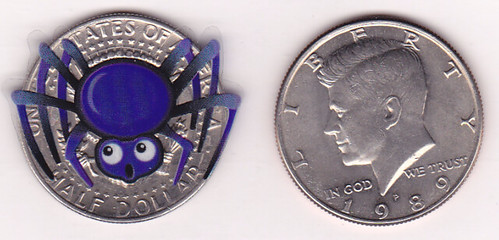
In the Happy-Halloween department, David Gladfelter writes:
A trick-or-treat idea that has worked well for us for a number of years is to put fright stickers on half dollars and hand them out. Many of the kids have never seen a half dollar before, and ask what they are. The kids are always happy, and so are we. No thrown-out fruit or candy littering our lawn, no parents disapproving of what the kids bring home, and best of all, no left over bags of candy growing stale for us to use up and gag on. This will work with quarters, foreign coins, whatever you want to use, but if you want to play Johnny Appleseed and bring back the forgotten half dollar to your neighborhood, you might give this idea a try. Have fun.
ALTERNATE TERMS FOR 'CENTER DOT'
I was impressed with Ken Spindler of San Diego with his citing the use of stop in lieu of center point. I refrained from elaborating on the alternate terms since it is quite trivial and some can be easily vexed by a presentation of a myriad of alternative terms, especially those who insist on a single term with intolerance to the use or display of others. So apologies to these sensitive readers. However, language is quite organic in nature and there are several alternatives to center point, and a stop is certainly one of them.
Mr. Johnson did cite interpunct, which is the more academic term and a quite nice one at that. Other useful terms to describe these markings on numismatic items are plentiful and not limited to the following : punctum, break, punkt, dot, point, period, bead, rondel, interpose, drop mark, and stigma mese.
Numismatic writers and catalogers should develop their own style and stick with whatever term they feel helps them and their audience understand what they wish to mean when describing a dot which is perfectly useful and clear a term in itself. I seriously doubt we shall ever see a numismatic writer refer to a dot in an inscription or legend as a stigma mese, which is a mid high marking used as a break. But, if one ever does I salute you. I like all of the fourteen terms and would be happy to see any of them used.
To read the earlier E-Sylum articles, see:
NOTES FROM E-SYLUM READERS: OCTOBER 15, 2017 : On What to Call Those Dots in Legends
(http://www.coinbooks.org/v20/esylum_v20n42a15.html)
WHAT DO WE CALL THOSE DOTS IN LEGENDS? (http://www.coinbooks.org/v20/esylum_v20n41a11.html) VOCABULARY TERM: LEGEND (http://www.coinbooks.org/v20/esylum_v20n41a12.html)
NOTES FROM E-SYLUM READERS: OCTOBER 22, 2017
Mint Director Dates of Service
Bob Julian writes:
In the October 15, 2017 edition of The E-Sylum there was some confusion over the dates for certain mint directors. The correct dates are as follows:
Robert Patterson, July 1, 1805, to July 14, 1824
Dr. Robert M. Patterson, July 1, 1835, to June 30, 1851
Dr. Henry R. Linderman (second term), April 1, 1873, to January 27, 1879
To read the earlier E-Sylum article, see:
U.S. MINT DIRECTORS WHO SERVED TWO TERMS (http://www.coinbooks.org/v20/esylum_v20n42a13.html)
The U.S. Mint and the Term "Mint Set"
Clifford Mishler writes:
In scanning through the contents of last week’s E-Sylum, Dick Johnson’s “Mint Set” submission caught my eye for a full reading. While have no argument with the basic description he sets forth, I would take issue with one detail; “ . . . sold by the mint that manufactured them or their sales agency.”
Back in the mid-1960’s, when Eva Adams and the United States Mint were intent on killing coin collecting, from their perspective, they had undertaken, by publication in the Federal Register, as I recall, to co-opt the application of the term “Mint Set” for exclusive use by the Mint. This was at the time that they introduced the marketing of the 1965 Special Mint Set packaging. At that time I undertook some research, which I’m unable to locate in any of my files presently, confronting they with it, which established that the term “Mint Set” had been applied to privately assembled coin sets back into the 1930s, at least, on the advertising pages of the Numismatic Scrapbook, and The Numismatist as well, I believe.
The bottom line is that the U.S. Mint was thwarted in their co-opting effort. Thus, a “Mint Set” is any set is today, really, any set of coins assembled of any mint’s coins, regardless of the point of assembly, or condition, in my opinion. In reality it could be a year set . . . or a set representative or an era or a time-frame . . . it would simply be appropriately representative of the products of that mint.
To read the earlier E-Sylum article, see:
VOCABULARY TERM: MINT SET (http://www.coinbooks.org/v20/esylum_v20n42a18.html)
An Update on Leopold Hamburger
Regarding his biographical article on dealer Leopold Hamburger in last week's issue, John Lupia writes:
I was looking through John Spring, Ancient Coin Auction Catalogues 1880-1980 (Spink, 2009) : 100-109, on the Hamburgers. David Fanning pointed out the reference so I put him in the acknowledgements. The main correction was that Leo Hamburger separated from Joseph on January 1, 1904, not in 1910 as I originally had it. Spring's book is excellent and I added it to the bibliography. I actually forgot about Spring's book when I wrote the piece.
To read the earlier E-Sylum article, see:
LEOPOLD HAMBURGER (1836-1902) (http://www.coinbooks.org/v20/esylum_v20n42a19.html)
The Netherlands/America Enduring Friendship Medal
Jonathan Brecher writes:
Last week you asked, "I didn't know we HAD a Netherlands/America Enduring Friendship medal. Now I'd like to see one, too. Can anyone help?" This eBay lot image is probably not good enough quality for publication, but should be fine to show the type.

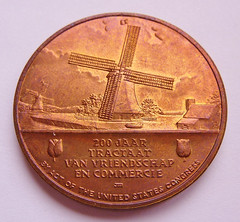
To read the complete lot description , see:
NETHERLANDS - AMERICA - ENDURING FRIENDSHIP 1782-1982 ~ COPPER MEDAL ~
1.5" dia (https://www.ebay.com/itm/NETHERLANDS-AMERICA-ENDURING-FRIENDSHIP-1782-1982-COPPER-MEDAL-1-5-034-dia-/152126804607)
The Swedish-American Friendship Medal
Alan Luedeking writes:
Your comment about the Netherlands/America friendship medal jogged something in my numismatic consciousness and brought to the fore a Swedish-American friendship medal issued in 1976 for the Bicentennial. No idea if it is a US Mint product or not, but it's large (50 mm) and heavy, and appears to be silvered bronze. Conspiracy theorists can have a field day with the reverse of this piece: look at what is approaching the twin towers.

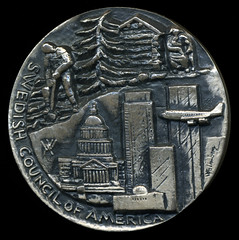
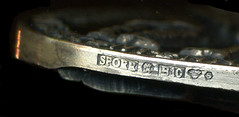
To read the earlier E-Sylum article, see:
QUERY: U.S. MINT MEDAL IMAGES SOUGHT (http://www.coinbooks.org/v20/esylum_v20n42a16.html)
Standing Liberty Quarter Game Counter
Jonathan Brecher writes:
Last week you asked, "Described by the seller only as an "UNUSUAL QUARTER MEDAL" this whatzit has a design similar to the U.S. Standing Liberty Quarter. But what exactly is it?" It's normally described as a counter. I don't know its original purpose.
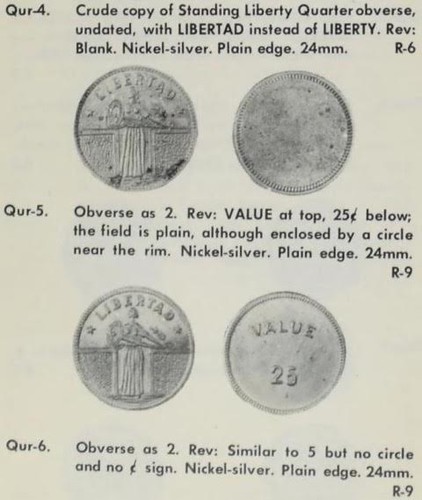
To read the full article on the Newman Portal, see:
To read the earlier E-Sylum article, see:
NUMISMATIC NUGGETS: OCTOBER 15, 2017 : Standing Liberty Quarter Lookalike Medal
(http://www.coinbooks.org/v20/esylum_v20n42a26.html)
Painting the Lily
Regarding the headline for one of Dick Johnson's items last week "GALVANO RELIEFS: GILDING THE LILLY", Arthur Shippee writes:
Beyond noting that the flower is a lily, the original quotation is to gild gold and paint the lily, a subtler and more telling phrase.
To read the earlier E-Sylum article, see:
GALVANO RELIEFS: GILDING THE LILLY (http://www.coinbooks.org/v20/esylum_v20n42a37.html)
Irving Berlin Congressional Gold Medal Image Sought
Mel Wacks writes:
In 1954, Irving Berlin was presented with a Congressional Gold Medal by President Eisenhower. Attached is a poor picture purporting to be the galvano. Can any of our readers supply a good photo of the medal?
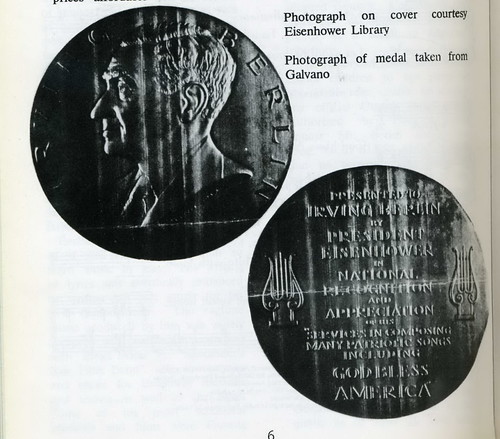

CHICKASAW BIG KEYS AND THE YOCUM SILVER DOLLAR
A web site visitor Mitch Caver writes:
 I do some research for the Chickasaw Nation. I happened to read your article on the Yocum Silver Dollar. I think I can shed a little light on the topic.
I do some research for the Chickasaw Nation. I happened to read your article on the Yocum Silver Dollar. I think I can shed a little light on the topic.
There actually was a Chickasaw in that area looking for the silver just after 1900. His name was Big Keys. Something that gives a little credence to the story is that he said they came from Georgia. Someone might think that indicates an error since the Chickasaws were from Mississippi but there actually was a group of Chickasaws near Augusta, GA that were there for about 80 years. They were given 10 square miles in appreciation for helping Oglethorpe against the Spanish in Florida. They left that area sometime before 1800 and came back to Mississippi which was their traditional homeland.
The timeframe for them leaving is earlier than implied by Big Keys but it oddly matches the same area. It was documented that there were Chickasaws living in northern Arkansas and the Missouri bootheel about the time he mentions. Some may have settled on the White River. Some had gone there very early when it was Spanish territory. I just thought you might like to read more about the story.
The attached newspaper article is from the The Pittsburg Press, July 26, 1910
The silver mine, according to Big Keys, was worked by the indians for several years. Large quantities of the ore were melted in a hollowed-out rock and molded into large bars in molds made of stiff clay, and carried to St. Louis and St. Charles, Mo., and traded for blankets and other necessities.
Fearing an attack by Mexicans, all valuables of the little band were placed in the cave and preparations made for a move to a new territory. the entrance to the cave was closed up with rock and dirt scraped from the mountainside, and covered to a depth of several feet...
Big Keys, who was then only a young brave, but now an old haggard Indian, was one of the few that found their way back to Oklahoma. In the last four years Big Keys has made several trips back to the White River territory in search of the long-lost cave...

To read the earlier E-Sylum article, see:
THE LEGEND OF THE ELUSIVE YOCUM SILVER DOLLAR (http://www.coinbooks.org/esylum_v18n39a14.html)
TRANSLATION OF THE 1783 CHARLES SPENER LETTER
Maureen Levine writes:
In response to your request for a better translation of the May 26, 1783, letter from publisher Charles Spener to Benjamin Franklin, I have added what Eric Newman and I used while researching our 2014 article. It was prepared by a friend fluent in French who did her best with the 18th century grammar and vocabulary. A couple of notes follow.
Sir, Having planned to publish, towards the end of September, an American almanac in Germany for next year, and wanting to illustrate it with many relevant engravings, of which the content does not need to be perfect; I dare turn to you and your extensive resources and knowledge of the history of the Anglo-American colonies even though I have yet to have the honor of making your acquaintance.
Allow me, sir, to briefly present to you the plan for this almanac, and then to ask for your kind assistance, either for information or the pieces themselves that I need and that certainly no one is better able to provide them to me than you, sir!
The almanac will first include the history of the revolution according to the best authors and with the most credible opinions that can be obtained. This topic will be illustrated with historical etchings, representing the most remarkable events of this war. Secondly: a gallery of famous American men with a summary of their political or military careers and illustrated with their portraits, copied from those drawn by du Simitier [Du Simitière] in Philadelphia and others that have been published in England. Seeing that you are a leader among these great American men, I beg your indulgence and as whether the portrait of you drawn by Pélicier for the Essay on Anglo-Americans is a close enough resemblance of you to serve as the model?
To make this gallery more complete, I will include famous American men, and it is here that I am having difficulty with the following portraits:
Portrait of John Adams
_________ Mr. Payne, author of Common Sense
_________ Dr. Warren, killed at Bunker Hill
_________ General Montgomery, killed in Quebec
_________ Mr. Paul Jones, Commodore in the service of the 13 United States [included -Maureen]
To these portraits, I would like to add the following pieces: The mausoleum erected by order of Congress to Dr. Warren
________ ditto ________________________ to the memory of General Montgomery
The medal struck by order of Congress to commemorate the capture of Major Andre
________ ditto _________________________________ the peace to immortalize the history of the Revolution
Form of paper money
Specimens of coins with the coat of arms of the 13 states
The coat of arms of the thirteen states
The flag of the thirteen states, in color
The uniform of the American troops, namely the regiments of Washington and Gates, in color
The historical section of this almanac has been entrusted to one of our best historians, Mr. Sprengel, history professor at the University of Halle, who has a thorough understanding of English and all the knowledge and qualities of a good historian. I dare say his work is worthy of your approval. Also, I would be honored to introduce him, and through your intervention, to the honorable members of Congress to whom I wish to pay tribute.
Forgive me, sir, that in pursuing this idea, I have dared to interrupt your serious occupations with a request of this kind, but please do me the honor of responding favorably to my humble request.
Finally, please allow me to add that from now until the end of September, the time set for the publication of almanacs in our country, is not far off, and the completion of different etchings require a considerable amount of time, so by providing me with the materials that I am missing as soon as possible, you would be adding infinitely to the good will that I ask of you. Bis dat, qui cito dat [He gives twice who quickly gives.]
Allow me, sir, to tell you of the veneration and the most heartfelt respect that I feel for you, the philosopher and statesman on two hemispheres. It is with these feelings that I have the honor of being your humble and obedient servant.
Charles Spener
Bookseller to the King
Maureen adds:
Notes on the letter above:
The requested medal “Struck by Congress to commemorate the peace” was illustrated in the Almanac by the Libertas Americana. Franklin’s “Explication,” as discussed in The Papers of Benjamin
Franklin, vol. 39, was “deliberately ambiguous,” in order to lead France to the conclusion that Congress, not Franklin, had ordered the Libertas Americana medals struck.
Spener’s request for “Specimens of coins with the coat of arms of the 13 states” was fulfilled by just one coin, the Continental dollar, with its linked chain design.
To read the earlier E-Sylum article, see:
MORE ON THE ORIGINS OF THE CONTINENTAL DOLLAR (http://www.coinbooks.org/v20/esylum_v20n42a23.html)
ONGOING THOUGHTS ON THE CONTINENTAL DOLLAR
Bob Leonard writes:
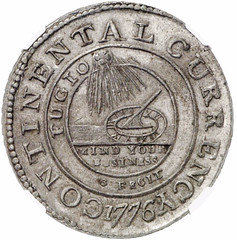 I was unaware that the term "pewter dollar," as Tom Wetter reports, was around before 1776: "I have a book from 1769 with a similar reference to 'pewter dollars' and
the only thing it does prove is that that term was in use before 1776, and it could discredit that poem." In that case "pewter dollar" must mean "counterfeit dollar;" thus
the poem has no reference to an actual coin. So much for my great discovery!
I was unaware that the term "pewter dollar," as Tom Wetter reports, was around before 1776: "I have a book from 1769 with a similar reference to 'pewter dollars' and
the only thing it does prove is that that term was in use before 1776, and it could discredit that poem." In that case "pewter dollar" must mean "counterfeit dollar;" thus
the poem has no reference to an actual coin. So much for my great discovery!
Consequently, I have changed my mind about the Continental Dollar, and now think that THE WHOLE ISSUE was struck in England in 1783, dated 1776. Everything points in that direction.
To confirm this, let's see whether we can identify the newspaper that the ad was cut from. And was there an engraver with the initials E G in London then?
"Silver is essential to a real dollar. If there is no silver in the seeming dollar, it is not a real dollar, but a counterfeit one."
"A pewter dollar, with a good stamp, and well washed over, is a real dollar, or it is not; if it is a real dollar, then silver is not essential to a real dollar."
For context, see:
p496, The Works of Joseph Bellamy, Volume 2
Since I returned from a trip to Scotland, I’ve been following the Continental dollar thread that began last month. Below are some thoughts, with more to come at a later date.
First, regarding the Eagleton article, those who are unaware of David Fanning’s astute analysis from the June 14, 2015, E-Sylum would do well to read it. In part, it says:
More serious objections to Eagleton’s argument arise from two factual errors. First, she mistakenly states that the paper money design on which the Continental dollar dies were based is signed by E.G. (generally taken to be Elisha Gallaudet):
“if this was meant to be a medal ‘representing’ the paper money, the presence on the Continental dollar of Gallaudet’s design and initials might not indicate any direct connection between him and the cutting of its dies. ... It might equally be a case of the die--sinker copying the design from the paper money faithfully in all details, including its errors, and also reproducing the signature of the engraver responsible for the printing plates from which the paper money had been made.” (page 298)
In fact, only the metallic dollar is so signed: the paper money is not. This is a fairly serious lapse.
A second serious lapse comes in Eagleton’s analysis of the printed advertisement. She clearly writes on page 298 that “the advertisement states that they were minted in Europe.” It does no such thing. There is absolutely nothing said in the advertisement about where the pieces were made. Indeed, the ad describes them as “American Medals,” which if anything implies that they were manufactured in America. The only source stating that the Continental dollars were struck in Europe is Banks (who was quoting Dryander), and this is evidence of nothing other than what they thought to be the case.
Second, in 1786, Richard Watson, in England, described the appearance and metallic composition of the Continental dollar, saying that it was coined by “The Congress in America.” The fact that Paul Revere denied knowledge of the coin was addressed by Philip Mossman in the December 1997 issue of The Colonial Newsletter, when he compared it to the fact that Thomas Jefferson “claimed that halfpence did not circulate in Virginia even though Virginia had minted its own.” (See pages 50-51 of the Newman/Levine article.)
I had written to Catherine Eagleton following the publication of her article asking for more information. I didn't hear from her, but I was hoping to illustrate the ad. A reader did forward me an image from the article, but it is copyrighted. I wish we could find the publication it was clipped from - there must be surrounding text that was omitted, and this could provide further clues. I don't subscribe to Numismatic Chronicle and haven't read the full piece. ANA members can read the Newman/Levine article on the association's web site. -Editor
Bob Leonard adds:
I took up my own suggestion to see whether there was an E G engraver in London then, searching the relevant pages in Forrer's Biographical Dictionary of Medallists, and found no one. But Elisha Gallaudet isn't listed either! The hunt must continue.
There are certainly errors in Eagleton's article and I don't endorse it in its entirety, but it is based on the indisputable evidence of a British newspaper ad offering Continental Dollars at an absurdly low price, far below face value (the Spanish milled dollar was rated at 16 times this in New York then). Someone in London had a quantity of them, so it is a stretch to argue that they were actually made in America in 1776, then shipped to England in 1783 to be sold for scrap tin. (Pinpointing the date and place of this ad would help greatly.)
Finally, saying that the Continental Dollar was coined BY "The Congress in America" does NOT mean that it was coined IN America, there being no Congressional mint here so late as 1783.
Bill Eckberg's submission started this thread. He writes:
Actually, very few Virginia halfpence did circulate. They had the misfortune of arriving in Virginia from London as revolutionary fervor was reaching a peak. Coins were hoarded, so Jefferson isn’t really wrong. It’s the only Colonial issue that is common in Mint State. It seems to be more common uncirculated than circulated. That, of course, could be a reflection of market forces, but there are a LOT of them in Mint State.
It’s been interesting. To my surprise, we haven’t come up with anything you could call real evidence either way. Honestly, I’m agnostic about where and when they were made, since there seems to be no actual evidence.
I am pretty sure that the Congress either didn’t know about them or didn’t consider them coins in 1782 when they regulated the value of everything that was in circulation at the time. But that doesn’t prove anything beyond that.
I also don’t believe there is any evidence that they were intended to be coins, wherever or whenever they were made. Almost none were made in a metal that would impress anyone at the time, and nearly all are in high grade, meaning they didn’t circulate.
HOWEVER, as I said before, I would be quite happy if someone were to find evidence demonstrating who struck them and why, whatever that finding led to.
Maureen adds:
During our research, Eric and I came across numerous mentions of “pewter dollars,” most of which were irrelevant or repetitious, and thus put aside. Without knowing the name of the book and in what context the terms appear, we have no way of knowing whether Tom Wetter’s book provides any useful information. The Bellamy quotation regarding counterfeit Spanish Milled Dollars appears in a 1769 religious work, and I don’t see its value in the context of this discussion.
The 1779 poem cited in our article, “The Congratulation,” by the Loyalist propaganda writer Jonathan Odell, has four stanzas with references that can only point to Continental paper currency: in brief, “paper coin refus’d for flour,” “Dollars on dollars heap’d up to the skies,” “Mock-money and mock-states,” “Taxes unpaid, tho’ payable in rags.” In the final stanza, Odell writes, “Congress will nobly pay him for his pains / Of pewter dollars, what both hands can hold.” In light of the rest of the 13-stanza poem, how can “pewter dollars” refer to anything but the Continental dollar coins?
Regarding Bill Eckberg’s response to the Mossman quote, the point is not how many Virginia halfpence circulated, it is that they did in fact circulate, and Jefferson was not aware of them.
To read the earlier E-Sylum articles, see:
SARAH SOPHIA BANKS AND THE ‘CONTINENTAL DOLLAR' OF 1776 (http://www.coinbooks.org/esylum_v18n24a06.html)
ON THE ORIGIN OF THE CONTINENTAL DOLLAR (http://www.coinbooks.org/esylum_v15n44a11.html)
ON THE ORIGINS OF THE CONTINENTAL DOLLAR (http://www.coinbooks.org/v20/esylum_v20n40a13.html)
NOTES ON THE ORIGINS OF THE CONTINENTAL DOLLAR (http://www.coinbooks.org/v20/esylum_v20n41a16.html)
MORE ON THE ORIGINS OF THE CONTINENTAL DOLLAR (http://www.coinbooks.org/v20/esylum_v20n42a23.html)
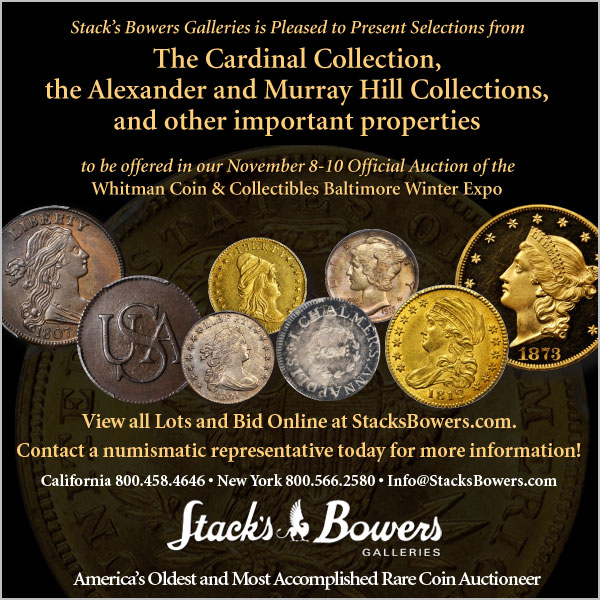
VOCABULARY TERM: FABRIC
Fabric. The quality or style of execution; the workmanship. Fabric includes the metal or composition of the coin or medal, the presentation of the design elements and
lettering, and evidence of how the piece was produced; it includes all the obvious elements, as well as those that are perceived only by a “sixth sense.” Fabric is a culmination of how the piece
looks and feels and is based on experience of handling many similar specimens. Though not conclusive, it is often an indication to the genuineness of a given coin or medal. Compare STYLE and
TECHNIQUE.
CLASS 03.2
Reference:
Doty, MACMILLAN ENCYCLOPEDIC DICTIONARY OF NUMISMATICS , p131
Looking for the meaning of a numismatic word, or the description of a term? Try the Newman Numismatic Portal's Numismatic Dictionary at: https://nnp.wustl.edu/library/dictionary
JOHN KIMBALL WIGGIN (1825-1875)
John Kimball Wiggin (1825-1875), was born on August 5, 1825 at Wakefield, Carroll County, New Hampshire, son of Porter Kimball Wiggin (1789-) and Elizabeth G. Wiggin (1789-) .
John Wiggin was a well-known book collector, publisher, book dealer, antiquarian bookseller, dealer in autographs, curios, rare engravings, prints, swords, coins, medals, and Tokens at his store at 14 Summer Street, and from 1864 to 1869 at 18 School Street, Boston, Massachusetts. He was also a coin collector and served as the Treasurer of the Boston Numismatic Society. He is the brother of Colonel Charles Porter Wiggin (-1877), the principal owner of the town of Nordhoff, Ojai Valley, California.
In July 1848, he was granted a license at Boston to be a funeral undertaker.
In 1851, he married Mary Jane Perry (1827-1900). They had a daughter Bertha (1859-1893).
In October 1859, he became a member of the New England Historic Genealogical Society. A few years later in the 1860's he worked with Jeremiah Colburn on the Committee of the Library of the N.E. Historic-Genealogical Society.
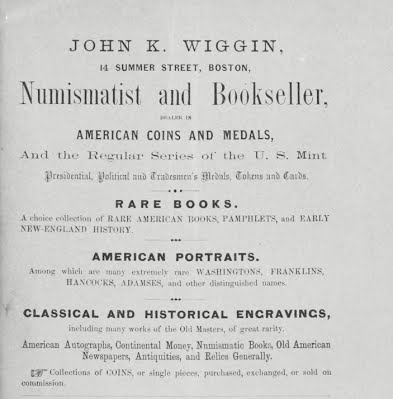
John K. Wiggin advertisement on the back cover of the Benjamin Haines coin auction catalogue January 19-23, 1863
The first of two known Wiggin coin auction sales selling U. S. coins was held at Leonard & Co., Boston, May 30, 1860.
The second known coin auction sale was catalogued by Ed Cogan held on March 25, 1862, held at William C. Cook, Philadelphia. Lot 747 described a 1792 silver center cent, Judd-1.
In 1869 he retired from his firm Wiggin & Lunt, Book and Publishing business. His partner William Parsons Lunt continued operating under his own name.
Leonard & Company auction sale held March 7-10, 1876 : Bibliotheca Americana : Catalogue of the Private Library of the Late John K. Wiggin, and the Duplicates Remaining from His Publications and Books on Sale, Chiefly Relating to America. There were many rare coin auction catalogues, and numismatic books in his collection in Lots 395-397, 402-415, 444-457, 461, 463, etc.
The auction sale of the autograph collection was also held by Leonard & Company on Tuesday, March 21, 1876.
He died of softening of the brain on August 20, 1875 at Boston, Suffolk County, Massachusetts. He is buried at the North Beverly Cemetery, Beverly, Essex County, Massachusetts.
To read the complete article, see:
WIGGIN, JOHN KIMBALL (http://www.numismaticmall.com/numismaticmall-com/wiggin-john-kimball)
The entire inventory of the Lupia Numismatic Library is for sale. Individual items will be available before the remaining archives are broken up into parcels sold at philatelic auctions in the U. S. and Hong Kong. Check NumismaticMall.com frequently as dozens of new items with estimates will be posted daily until everything is sold.
All inquiries will be given prompt and courteous attention. Write to: john@numismaticmall.com .
PAN TO AUCTION JOHN MERCANTI PLASTERS

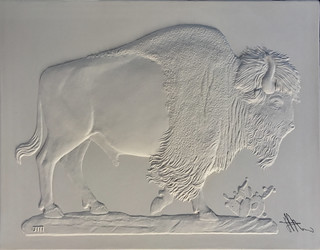
U.S. Mint 12th Chief Engraver John Mercanti has created two bas-relief plaster sculptures that will be the highlight of the PAN Benefit Auction to occur on the evening of Thursday October 26th during the association’s yearly banquet that is held in conjunction with the PAN Fall Coin Show and Convention on October 26th thru 28th Thursday, Friday and Saturday at the Monroeville Convention Center, Pittsburgh, PA
The first sculpture is a beautiful likeness of 26th President of the United States, Theodore Roosevelt Jr. The piece is hand signed by Mr. Mercanti. His work is world-renowned and this sculpture of TR is a stunning example of his accomplished talent.
The second item is a majestic Bison. A similar example with a mountain range in the background was auctioned at the previous PAN banquet. This sculpture does not have the mountain range but does include a small cactus. John has hand signed this piece. The PAN Banquet will be held at the LeMont Restaurant on top of Mt. Washington overlooking the popular view of the City of Pittsburgh. Tickets and more details can be found on the PAN website www.PANcoins.org or by calling PAN President Tom Uram at 412-418-0783.
For more information, see:
https://pancoins.org/
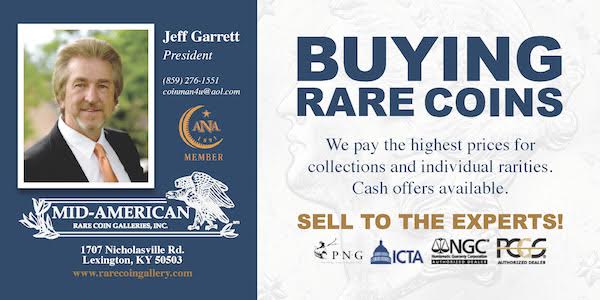
COLONIAL PAPER RARITIES IN NEWMAN PART VIII
Exceptional Colonial Offerings in Newman Part VIII Currency Auction
Selections from the Eric P. Newman Collection Part VIII will be offered November 1 and 2 at Heritage Auction’s world headquarters in Dallas in conjunction with the Newman Part IX coin sale (November 1 and 3). Exceptional unreserved Colonial notes are featured, and a few of the many highlights are detailed below.
Lot 28038: Maryland July 14, 1756 20 Shillings
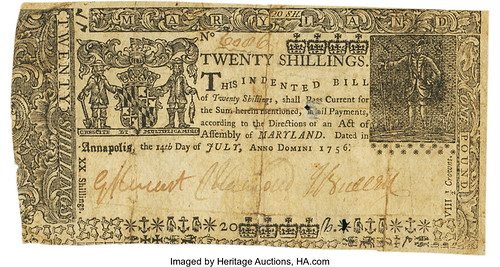
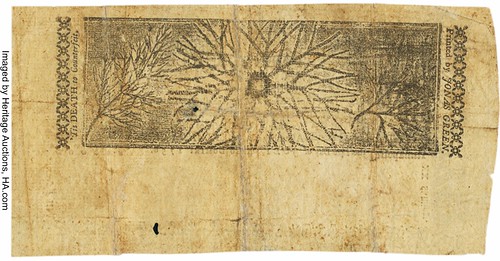
The exceedingly rare July 14, 1756 Maryland 20 shillings note is so seldom encountered, the only auction record we have located is from the Roper sale in 1984. Boyd did not own an example from the series, and very few are held in private collections. This example has a nature-print back and was boldly printed by Jonas Green. Another opportunity to own one of these underrated rarities might not arise for another three decades.
To read the complete lot description, see:
Maryland
July 14, 1756 20 Shillings Fr. MD-37. PCGS Very Fine 25 Apparent.. ...
(https://currency.ha.com/itm/colonial-notes/maryland/maryland-july-14-1756-20-shillings-fr-md-37-pcgs-very-fine-25-apparent/a/3547-28038.s?type=surl-3547--28038&short=3547*28038)
Lot 28111: Pennsylvania August 1, 1744 1 Shilling

Notes printed by Benjamin Franklin are always in demand. This finest known, and likely unique, August 1, 1744, Pennsylvania shilling has the added benefit of a stellar EF 45PPQ grade. This beautifully detailed example is the Newman plate note. Although Boyd had two notes from the issue, they could not approach the virtually pristine condition seen here.
To read the complete lot description, see:
Pennsylvania
August 1, 1744 1 Shilling Fr. PA-46. PCGS Extremely Fine 45PPQ.. ...
(https://currency.ha.com/itm/colonial-notes/pennsylvania/pennsylvania-august-1-1744-1-shilling-fr-pa-46-pcgs-extremely-fine-45ppq/a/3547-28111.s?type=surl-3547--28111&short=3547*28111)
Lot 28132: Rhode Island February 14, 1743 2 Shillings 6 Pence
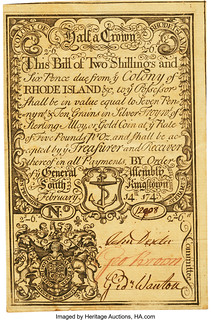
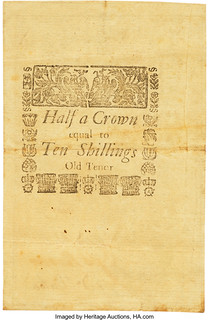
Another Newman plate note in stellar condition is the Rhode Island February 14, 1743 “Tall” Bill of Credit. Only Roper had an example, which had splits and faults, and that was sold in 1984; the Boyd collection examples were all redated plate notes. Beautifully engraved and boldly printed, this is a priceless treasure.
The engraved face plate, which was subsequently redated for a few more issues, is one of the most handsomely designed plates in the 1690-1750 New England Bill of Credit issuing period. The cartouche occupying the top two thirds of the note contains the obligations; the sides show floral details; the Rhode Island anchor motif symbolizing Hope is at bottom center; and the top displays fancy engraved details in the corners with "Half a Crown" in the center. Outside of the cartouche, at the bottom left, are the Royal Arms with the Garter crest and motto at center. The back is simpler, with an ornamental square cartouche composed of mixed types such as crowns, urns, plumes and roses. At center is "Half a Crown / equal to / Ten Shillings / Old Tenor." A very bold note with three clear signatures and serial no. 12908 at the lower right. A deeply inked, strong plate was used to print this note.
To read the complete lot description, see:
Rhode
Island February 14, 1743 2 Shillings 6 Pence Fr. RI-54a. PCGS Extremely Fine 45.. ...
(https://currency.ha.com/itm/colonial-notes/rhode-island/rhode-island-february-14-1743-2-shillings-6-pence-fr-ri-54a-pcgs-extremely-fine-45/a/3547-28132.s?type=surl-3547--28132&short=3547*28132)
Lot 28138: South Carolina August 27, 1715 Act 4 Pounds
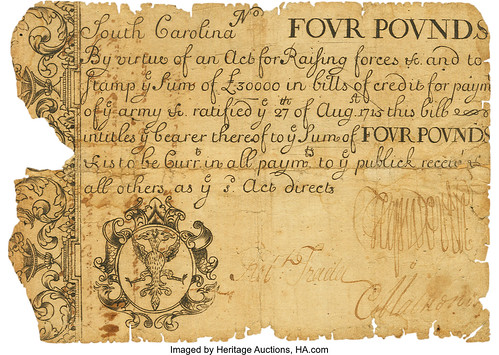
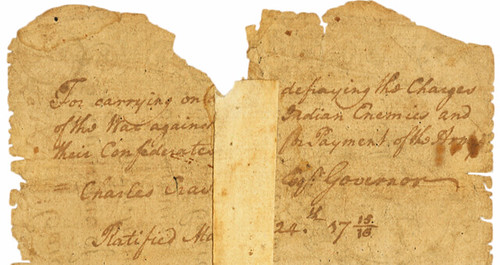
The third Newman plate note, and the finale in these highlights, is the unique and impressive South Carolina August 27, 1715 Act 4 pounds note for “Raising forces” to quell the Native American uprising. This is the earliest confirmed Southern Colonial bill and a tangible artifact of the Yamassee War, a key event in South Carolina’s history with an impact comparable to that of King Philip’s War in New England. Although with some faults, this is on a par with the most significant of all Colonial issues and will be a centerpiece of the next cabinet it enters.
This 1715 Proprietary period Bill of Credit is equal in stature to the most significant Colonial notes known. It is the earliest confirmed southern Colonial bill. Due to its direct use for military funding at the onset of the Yamassee War and other engagements with Native Americans, it is comparable to the 1690/91 Massachusetts bills used to pay for the unsuccessful military expedition to Quebec.
Under proprietary rule, the Colony was loosely governed by the aristocratic elite whose commercial aims were to expand territory, increase agricultural output (particularly rice), and facilitate commerce. The British traded widely with the Native Americans, who engaged in selling them captured slaves from rival tribes (whether for monetary gain or to pay off escalating debts with British traders) in addition to goods such as deerskins. As further land was needed for rice production, the British expanded more aggressively into Yamassee territory, and trading practices with these Native American "allies" became more predatory. The resulting atmosphere of discontent and mistrust led to the 1715-1717 Yamassee War.
On April 15, 1715, the Yamassee attacked and killed trade officials in Pocataligo. A week later, Governor Craven responded with military force. Other tribes across the southern region rose up (some in solidarity, and others because they were no longer confident of the British keeping their promises), attacking colonists and killing hundreds including most of the traders. Like King Philip's War in New England, the Yamassee War outcome would be a key event in the survival of the Colony, where much already had been invested in the slave economy and development of ports like Charles Town (Charleston). The last major battle occurred in July 1715 (although skirmishes would last until 1717). The Yamassee began moving south the following month, after the Colony received replenishments of supplies, an act funding a large militia was passed, and ten forts were erected. The war contributed to the Lords Proprietors eventually losing influence and South Carolina becoming a Crown colony.
To read the complete lot description, see:
South
Carolina August 27, 1715 Act 4 Pounds Fr. SC-17. PCGS Fine 15 Apparent.. ...
(https://currency.ha.com/itm/colonial-notes/south-carolina/south-carolina-august-27-1715-act-4-pounds-fr-sc-17-pcgs-fine-15-apparent/a/3547-28138.s?type=surl-3547--28138&short=3547*28138)
Bidding has begun, and we invite you to view the exciting Newman VIII notes at HA.com/3547 as well as the Newman IX coins at HA.com/1260 .
WAYNE'S NUMISMATIC DIARY: OCTOBER 22, 2017
On Tuesday, October 17, 2017 I attended the 2017 United States Mint Numismatic Forum at the Mint HQ in Washington, D.C. It had been many years since I'd visited the building (I believe it was for a meeting with Mint Director Philip Deihl).
The new Silver Line metro extension hasn't quite reached our suburban neighborhood yet, so I decided to drive in. The commute wasn't bad and I parked in a surface lot nearby. As I entered the building I ran into Coin World correspondent Steve Roach. We went upstairs and checked in, then struck up a long conversation with Charles Morgan of CoinWeek.
Charles and his fellow CoinWeek writer Hubert Walker published an excellent article on the event. It's linked below, so be sure to read that for a full account. Here are my own pictures and notes.
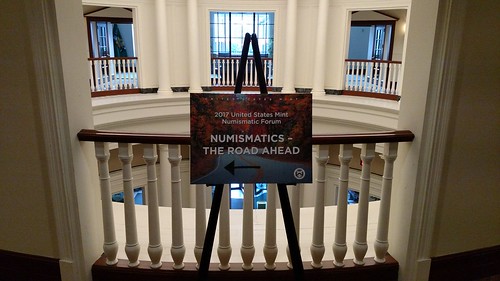
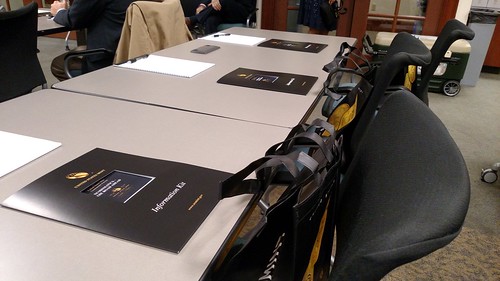
The Forum was well-organized with staffers escorting participants upstairs to the meeting room, which was set up with comfortable tables and chairs, each place set with an agenda folder, notepad and goodie bag. In the closest I'll ever get to "free samples" from the Mint, mine included a 2x2 flip with a 2017-P cent and a blank cent planchet. Nice.
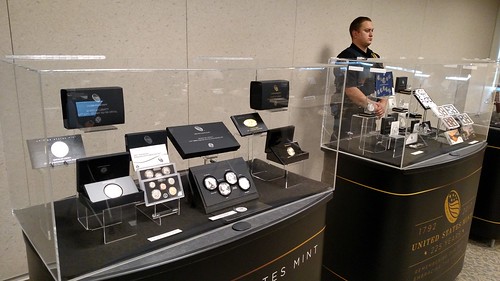
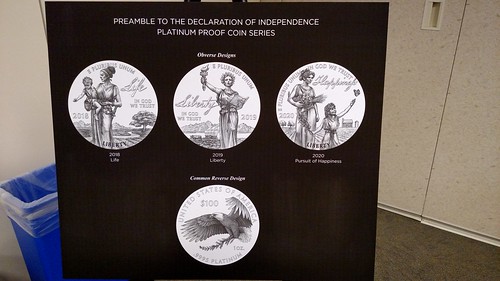
The back of the room held display cases watched over by U.S. Mint Police.
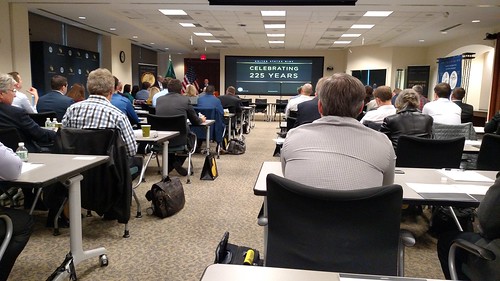

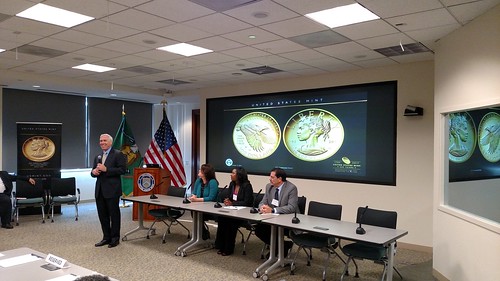
Above are some shots of speakers and the audience.
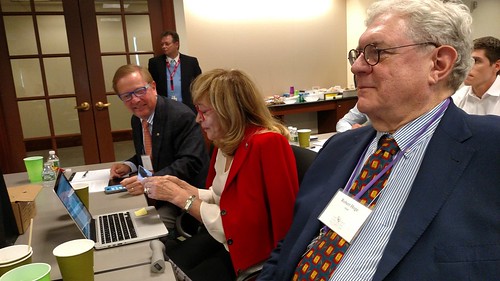
Here are my tablemates: Robert Hoge and his wife Imma, and ANA Governor and CCAC Member Tom Uram.
I didn't realize the format would be different than last year's forum, where attendees split up into focus groups to discuss various topics and make recommendations to the Mint. I'd come prepared to pass along some complaints and suggestions I'd gathered from fellow club members, but never really got a chance to share them. But I was heartened to see that some requests and suggestions from last year's Forum had been adopted by the mint.
It was a large crowd and I saw a number of familiar faces and had a chance to speak with many of them on the breaks including Citizens Coinage Advisory Committee (CCAC) members (and former members) Don Scarinci, Mary Lannin, Jeanne Stevens-Sollman, Erik Jansen, Robert Hoge, Tom Uram, Steve Roach and Roger Burdette. Other folks I spoke with included Hubert Walker of CoinWeek, formet ANA President Jeff Garrett, and Mary Burleson of Whitman Publications.
On the way out I took several pictures of the building and some displays. It's a very nice structure and my only regret is that I didn't have time to get a closer look at everything.


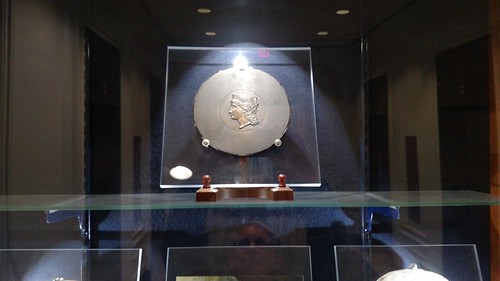
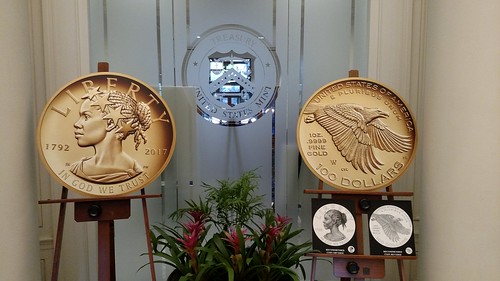
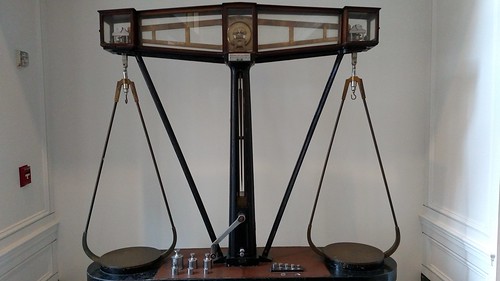
CoinWeek Coverage
As mentioned earlier, Charles Morgan and Hubert Walker published a thorough write-up of the event. See the complete article online. But here are some images I greatly enjoyed seeing during the
presentations.

2017 Palladium Nonsense Design Pattern
To read the complete CoinWeek article, see:
Second United States Mint Forum Casts Mint Marketing Behemoth in New Light
(https://coinweek.com/us-mint-news/second-united-states-mint-forum-casts-mint-marketing-behemoth-in-new-light/)
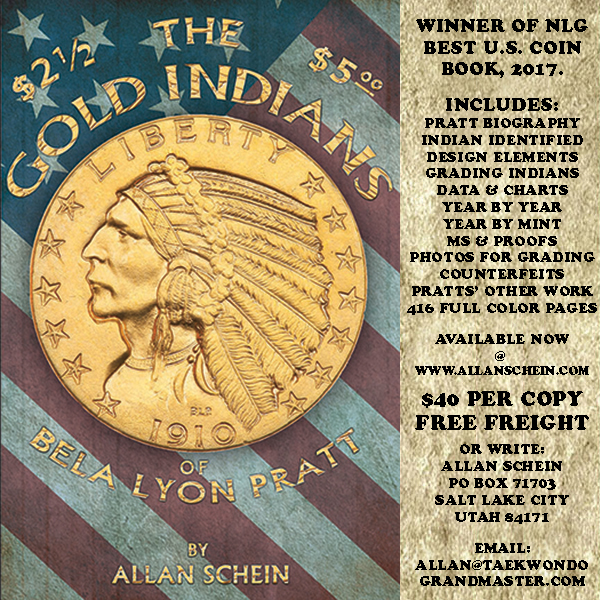
VIDEO: ROYAL CANADIAN MINT'S GOLD PRODUCTS

Canada marked a special birthday this year, turning 100 years old and the Royal Canadian Mint decided to commemorate the event with a special edition coin – the Canada 150 gold coin. Kitco News got an inside look into how much work goes into getting new coins on the market. Speaking with the mint’s VP of sales Chris Carkner, Daniela Cambone learns everything from the mint's special edition 'Voyageur' coin to what makes the Maple Leaf bullion coins so unique. Stay tuned, we’ll have more videos coming to you from our Mint tour, which includes an exclusive look into the mint’s unique refining and production process.
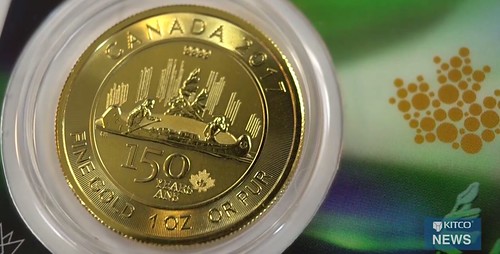
To view the complete video, see:
Behind the Coin: Inside Peek Into the RCM's Gold Products
(http://www.kitco.com/news/video/show/Kitco-News/1744/2017-10-19/Behind-the-Coin-Inside-Peek-Into-the-RCMs-Gold-Products)
SWITZERLAND’S NEW TEN FRANC BANKNOTE
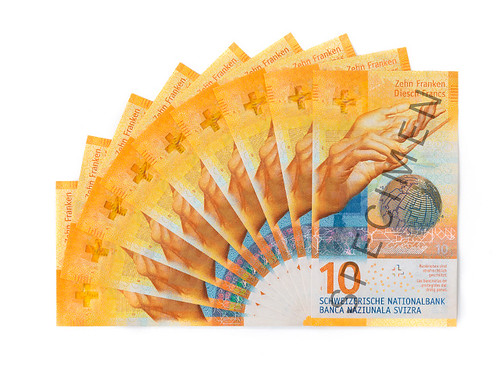
The Swiss National Bank on Wednesday revealed the country’s new ten franc note, which will go into circulation on October 18th.
The latest in the new series of banknotes that is being issued in stages, the ten franc note follows the 50 franc and 20 franc notes that entered circulation in April 2016 and May 2017 respectively.
Each note in the new series depicts a characteristic of Switzerland, illustrated by various graphic elements including a hand and the globe, which appear on every note
The ten franc note focuses on Switzerland’s organizational talent, expressed in the key motif of time, said the SNB in a statement.
The new note is the same colour as its predecessor but – as with all the new notes – is smaller and has more sophisticated design and security features than the previous banknote series.
To read the complete article, see:
Switzerland’s new ten franc banknote unveiled
(https://www.thelocal.ch/20171011/switzerlands-new-ten-franc-banknote-unveiled)

SWISS BANKNOTE DESIGNER MANUELA PFRUNDER
 The third in a series of gorgeous new Swiss franc bank notes will be released by the Swiss National Bank (SNB) on October 18th. The 10-franc note keeps its yellow colour, but most
everything else in the design and construction is different.
The third in a series of gorgeous new Swiss franc bank notes will be released by the Swiss National Bank (SNB) on October 18th. The 10-franc note keeps its yellow colour, but most
everything else in the design and construction is different.
What’s most remarkable about the new bank note? Not the 40 centimes or so it takes to make each note, nor that each note is projected to last only about a year. Not the sophisticated security measures, including multiple layers of transparent and inked polymers, paper and other materials, plus other features embedded to combat counterfeiting – all this is done in Zürich by Orell Füssli.
Most remarkable is what this note, like the rest of the new series, does not have. Swiss francs, like most world currencies, have long featured notable faces from the past. But now, each beautiful note is designed around an abstract theme related to Switzerland. For the 10-franc note, instead of the retired portrait of the controversial genius Le Corbusier, the theme “focuses on Switzerland’s organizational talent – expressed by time”, says the SNB.
On one side it has a pair of hands conducting an orchestra, a globe showing time zones, tiny clock faces, and nearly microscopic graphics celebrating the punctual Swiss rail system.
The first of the new Swiss franc notes to be released was the 50-franc note. Its theme is wind. It won an international competition as best new bank note of 2016. Then came the 20-franc note, designed around the theme of light.
Tying together the designs of all the new Swiss franc notes is the human hand. On the 50-franc note, the hand holds a dandelion, its seeds scattering in a puff. The hand on the 20-franc note holds a prism refracting light. The 10-franc note shows an orchestra conductor’s hands keeping time with her baton.
But are those a woman’s hands? What about the hands on the 50-franc note and 20-franc note? Are they a man’s or a woman’s hand?
“It’s a secret”, says Manuela Pfrunder, with a laugh. Pfrunder designed all the notes. “There are six bank notes. We had six different models”, she says. Some were men, some women. The hand art on the notes is true to the models’ actual hands. Was she one of the hand models? Pfrunder won’t say – but don’t these long fingers (below) look a little like those on the 10-franc note?
To read the complete article, see:
The new 10 Swiss franc note hand mystery
(http://lenews.ch/2017/10/11/the-new-10-swiss-franc-notes-hand-mystery/)
UKRAINE BANS RUSSIAN CRIMEA BANKNOTE

Russian Central Bank Governor Elvira Nabiullina
presents the new 200 ruble banknote
Ukraine has banned a new Russian banknote that includes images from the annexed Ukrainian region of Crimea.
The National Bank of Ukraine announced on October 13 that the new Russian 200 ruble ($3.50) bill showing a memorial in Sevastopol, a ruin in Chersonesus, and a map of Crimea would be illegal in Ukraine beginning on October 17. Banks and exchanges will not accept them.
The bank's statement said the ban covers any Russian currencies depicting "maps, symbols, buildings, monuments" or other objects "based in Ukrainian territories occupied by Russia."
Russia presented the new banknote on October 12.
Ukraine and Russia have been locked in a standoff since Russia illegally annexed Crimea in 2014 and began offering military, economic, and political support to separatists in parts of eastern Ukraine.
More than 10,000 people have been killed, at least 23,900 have been injured, and some 1.6 million people have been displaced by the conflict in eastern Ukraine since the spring of 2014.
To read the complete article, see:
Kyiv Bans Russian Banknote Featuring Crimean Images
(https://www.rferl.org/a/kyiv-bans-russian-banknote-featuring-crimean-images/28794716.html)
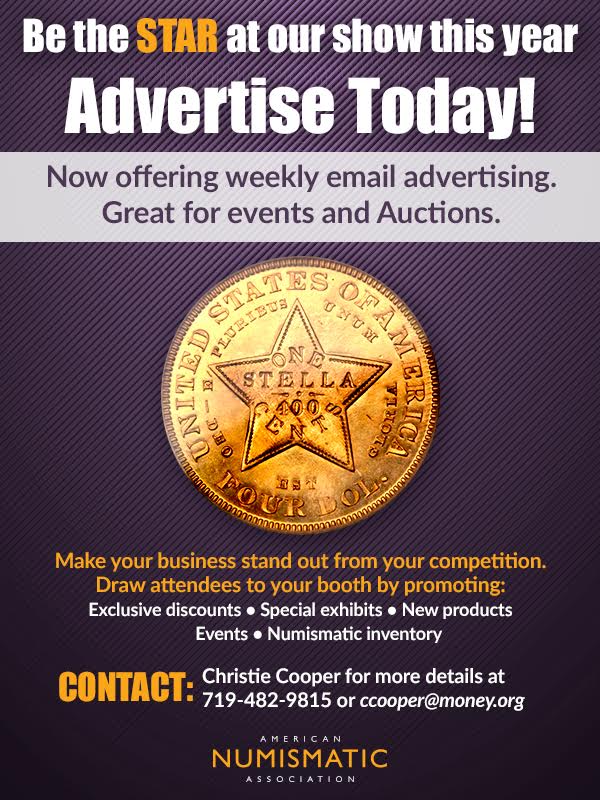
ARTIST WINS AWARD FOR LINCOLN PENNY PORTRAIT
 A penny saved might be a penny that earned $200,000 — so knows Battle Creek graphic designer Richard Schlatter, the grand prize public vote winner of this year’s ArtPrize for his
24,000-penny, 12-foot-tall portrait, “A. Lincoln.”
A penny saved might be a penny that earned $200,000 — so knows Battle Creek graphic designer Richard Schlatter, the grand prize public vote winner of this year’s ArtPrize for his
24,000-penny, 12-foot-tall portrait, “A. Lincoln.”
U.S. Government teacher Tak Ready considers his pennies lucky. He also has a penny presidential portrait of Abraham Lincoln hanging in his Traverse City West Senior High School classroom.
Beautifully crafted with 6,000 pennies by his best friend and fellow educator, David Kirby, the 4-foot-by-6-foot portrait took on added meaning over the weekend when the larger penny portrait of Lincoln took first place in the international Grand Rapids ArtPrize Nine competition.
And though Schlatter took home the $200,000 top prize for his at this year’s ArtPrize, the 48-year-old Ready said he values his penny portrait even more.
“I did see the penny portrait in Grand Rapids a few weeks ago,” said Ready. “It was massive and pretty impressive. The one in Grand Rapids is cool, but Kirb’s is better. Plus, the one in Grand Rapids is way too big — 12-feet-tall-by-8-feet-wide — and would never fit in my classroom.”
Penny art has been around since pennies themselves. Because of the varied hues of copper, brown, tan — and steel pennies from the World War II years — pennies offer an almost endless opportunity for artistic expression.
“It’s very, very heavy,” said Kirby, who teaches physics at the same high school. “There is a pattern of special pennies throughout Tak’s portrait — special dates, penny versions including Indian Head and a WWII steelie. The portrait required a lot of problem solving. Where do you get a working surface that big, since it had to hold two copies of it at once?”
The answer? A table tennis table located in Kirby’s boathouse.
“I created the portrait twice, both full size,” said Kirby. “After the penny placement was perfect, I had to pick up a row of 200 pennies in a reverse order — a big stack — then transfer them to the second piece of canvas, lay them down in forward order and then glue them down with shoe goo, over and over and over.”
Getting the enormous penny portrait to school to surprise his friend became another matter.
“It’s like a copper blanket that you can’t roll up, or fold, and is heavy as sin,” said Kirby.
He and his son, Cooper, walked it into West Senior High School and left (the penny portrait) in the cafeteria for Ready to see, just before Christmas in 2013.
“When I walked in to school later that morning through the cafeteria, and saw a huge penny portrait hanging there on a wooden frame, my jaw dropped in amazement,” Ready recalled. “I knew right away Kirb’ had made it. When I later found out it was a gift for me to put in my classroom, I knew I had received the best gift ever.
To read the complete article, see:
Smaller version of $200K ArtPrize winner hangs in high
school (http://www.record-eagle.com/news/local_news/presidential-pennies-on-the-dollar/article_2eef083c-b775-5c13-8daf-1c523b296656.html)
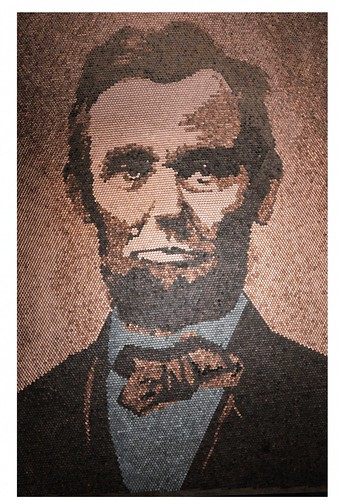
Over 24,000 Lincoln pennies were used to create a portrait of Abraham Lincoln. Included are the use of 1,681 1943 steel pennies (for the shirt). Every year from 1909, the first year of the Lincoln cents, through 2017 is represented in the piece, which measures 8 feet wide by 12 feet high—a total of 96 square feet. It took about 315 hours to complete. The image changes as the viewer moves from side to side and views the piece from different angles and distances.
To read the complete article, see:
A. Lincoln (http://www.artprize.org/65175)
FEATURED WEB SITE: BRIANRXM
Has Good Ol’ Mr. Wilson been Grooming a Young Numismatist for decades now?
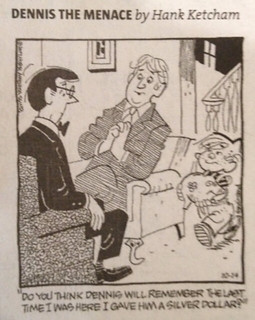 Saturday’s edition of the Denver Post newspaper had this Dennis the Menace comic (by Hank Ketchum) that mentioned a silver dollar. I seem to recall “good ol’” Mr. Wilson next door
trying to interest Dennis in coin collecting on other occasions.
Saturday’s edition of the Denver Post newspaper had this Dennis the Menace comic (by Hank Ketchum) that mentioned a silver dollar. I seem to recall “good ol’” Mr. Wilson next door
trying to interest Dennis in coin collecting on other occasions.
A quick search on Google followed by another search on the PCGS Collector’s Universe U.S. Coin Forum gave me the answer I was looking for, and much more. The Google search led me to a website simply titled, “BrianRxm” and a page titled, “COINS ON TELEVISION / DENNIS THE MENACE (1959-1963).” The first show listed is, “Dennis and the Rare Coin first shown January 17, 1960 (Season 1 Episode 15) where “Mr. Wilson pays $250.00 for a rare gold coin from a con artist.” Per the website, “The episode shows a 1907 $10 gold coin.”
There are about a dozen episodes with coins featured, ranging from an 1895 Silver Dollar to Dennis depositing 300 pennies [sic.!] at a bank where Mr. Wilson works.
Further exploring the www.BrianRxm.com website leads to another page, with "Coins on Television / Television Stars / Coins Appearing in Television Programs.” Hawaii Five-O, Andy Griffith, Beverly Hillbillies, Dragnet, and many others, some familiar, some not-so familiar.
Entering “Coins on Television” in the PCGS Forum Search Bar shows someone going by “WillieBoyd2” in various discussions on this subject from 2013-2017. It appears this is his website, and a good one. This is confirmed by a note at the bottom of one of the website pages, “This website has been viewed more times than you can imagine.” I hope you enjoy it.
www.brianrxm.com

